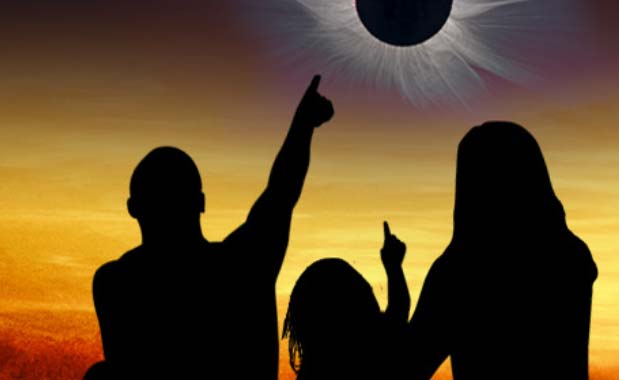
In the Boston area, where I live, about 95 percent of the sun will be blocked by the moon during the solar eclipse that will cross North America next Monday. But four close family members — a son in Dallas, a sister in Cleveland, a sister-in-law in Indianapolis, and my wife's mother in Alexandria Township, N.Y. — live within the path of totality and will be able to view the stunning event by simply stepping outdoors and looking up. When I mention to Peter Tyson, the editor in chief of Sky & Telescope magazine, that some of those relatives tell me they've grown weary of the hype attending the upcoming astronomical spectacle, he is incredulous.
"Tell them that a total eclipse of the sun is the most stunning heavenly event you can view from the Earth's surface," he says. "If they witness it next week, they will remember it for the rest of their lives."
I had stopped by Tyson's office in Harvard Square to pick up the special issue of Sky & Telescope published in advance of the April 8 eclipse. In a letter to readers that opens the issue, Tyson has disappointing news for those of us who will be stuck outside the zone of totality. "The truly exhilarating, even life-changing experience only comes with a total, not a partial, eclipse," he writes, analogizing it to breaking the sound barrier: "Anything up to Mach 1 is thrilling, but only beyond it do you trigger a sonic boom."
So profound is the discrepancy between the two that not even a 99 percent partial eclipse, which is what cities like Louisville, Ky., and St. John's, Newfoundland, will experience, can compare to totality. There will be no visible corona, no red feathery prominences leaping outward from the sun's surface, no special appearance of the stars and planets. If just 1 percent of the solar disc remains uncovered, it will still be 10,000 times brighter than a full moon.
Psychologist Kate Russo, who has viewed 13 total solar eclipses and written extensively about people's reactions to them, describes the sight as "so otherworldly that you think it's a special effect for some science-fiction movie. You find yourself screaming excitedly, not knowing what you're saying. … A black hole appears in the sky where the sun should be, like a celestial eye gazing back at you. … The world suspends in time, as you are lost in your own little rapture."
Total solar eclipses aren't actually that rare; one occurs somewhere on earth every 18 months or so. But for a given location to find itself in the middle of a total eclipse is rare indeed: It happens on average only once every four centuries. So is it any wonder that eclipses evoke such fascination, or that so many people will journey to see one? Seven years ago, when a solar eclipse traversed the continental United States from ocean to ocean, millions of Americans took to the road, causing ferocious traffic jams and what The Atlantic called "the greatest temporary mass migration of humans to see a natural event in US history." Next week, it is estimated that as many as 3.7 million people who live outside the path of totality will travel to see the eclipse.
In person or remotely, hundreds of millions of Americans will be watching the spectacular celestial show on April 8, easily dwarfing the number of people who watched Super Bowl 2024. If only for a few minutes, we the people will be united during the eclipse in a way Americans almost never are anymore. And what will bond us that day will not be something dreadful, like a terrorist attack or a natural disaster, but an ineffable heavenly wonder, marvelous and eerie and lovely. Ah, if only I could be in the path of totality with one of my relatives to see it in person.
Jeff Jacoby is a columnist for The Boston Globe, from which this is reprinted with permission."


 Contact The Editor
Contact The Editor
 Articles By This Author
Articles By This Author